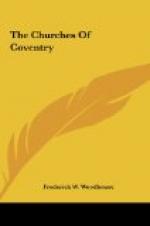The yearly revenue had been certified in the valuation at L731 19 s. 5_d_. Deducting a Fee-Ferme rent to the Crown, reserved by Roger de Montalt, and other annual payments, the clear remainder was L499 7_s_. 4_d_. Bishop Rowland Lee, writing to “my singular good Lord Cromwell,” implies that he had a promise from him to spare the church. “My good Lord,” he says, “help me and the City both in this and that the church may stand, whereby I may keep my name, and the City have commodity and ease to their desire, which shall follow if by your goodness it might be brought to a collegiate church, as Lichfield, and so that fair City shall have a perpetual comfort of the same, as knoweth the Holy Trinity, who preserve your Lordship in honour to your heart’s comfort.”
But his entreaties, and those of the mayor and corporation, were all in vain, the church and monastic buildings were dismantled and destroyed piecemeal, and like so many other magnificent structures became a mere quarry for mean buildings and the mending of roads.
The site having been granted by Henry VIII to two gentlemen named Combes and Stansfield, passed soon into the hands of John Hales, the founder of the Free School, and in Elizabeth’s reign was purchased by the Corporation.
The changes in religious opinion of the successive sovereigns were felt here by many poor victims. Seven persons were burnt in 1519 for having in their possession the Lord’s Prayer, the Ten Commandments, and the Creed in English, and for refusing to obey the Pope or his agents, opinions and acts that would have been counted meritorious twenty years later. In 1555 Queen Mary burnt three Protestants in the old quarry in Little Park—Laurence Saunders, a well-known preacher, Robert Glover, M.A., and Cornelius Bongey.
Ten years after this Queen Elizabeth’s visit was the occasion of much pageantry and performing of plays by the Tanners’, Drapers’, Smiths’, and Weavers’ Companies, and in 1575 the men of Coventry gave their play of “Hock Tuesday” before her at Kenilworth Castle. In 1566 Queen Mary of Scots was in ward here, in the mayoress’ parlour, and in 1569 at the Bull Inn.




